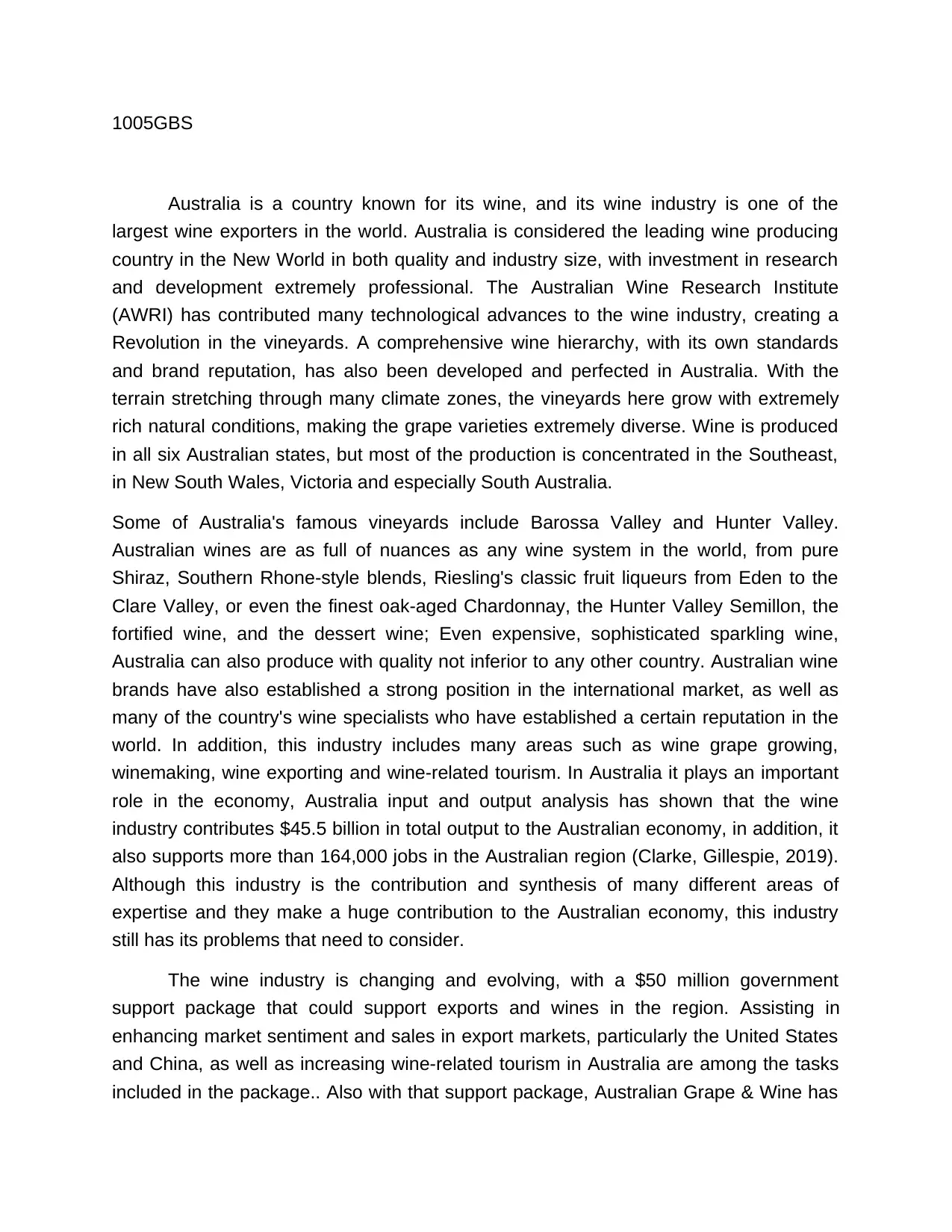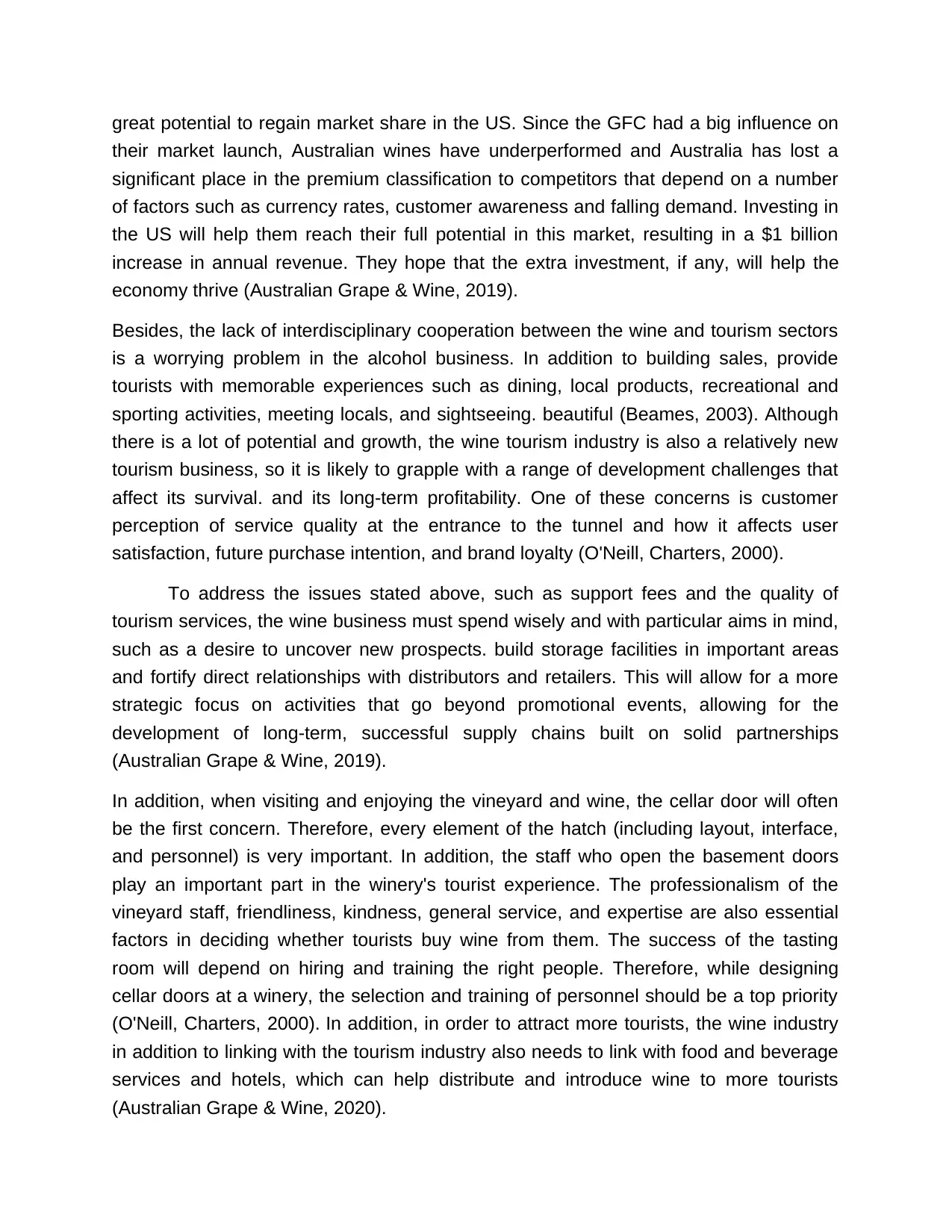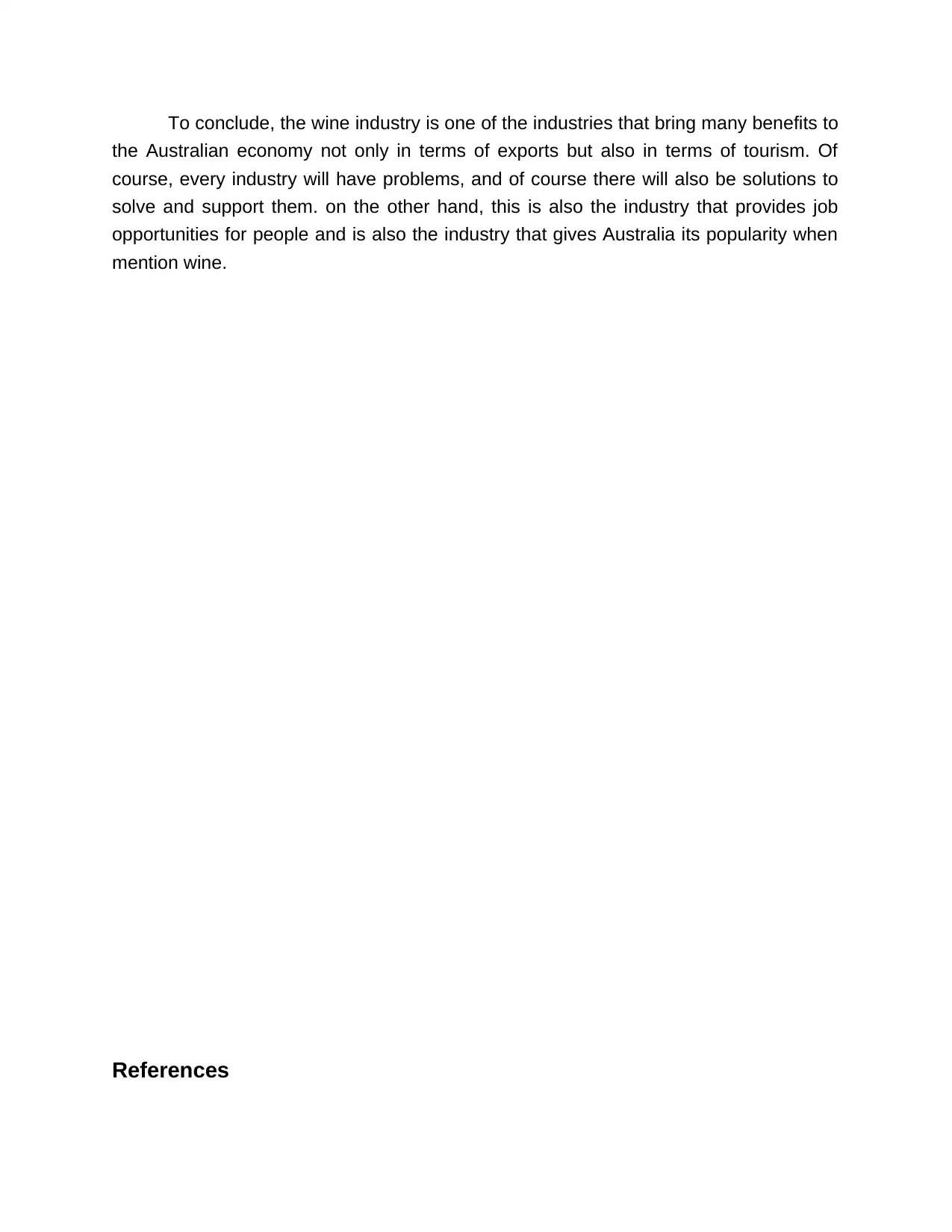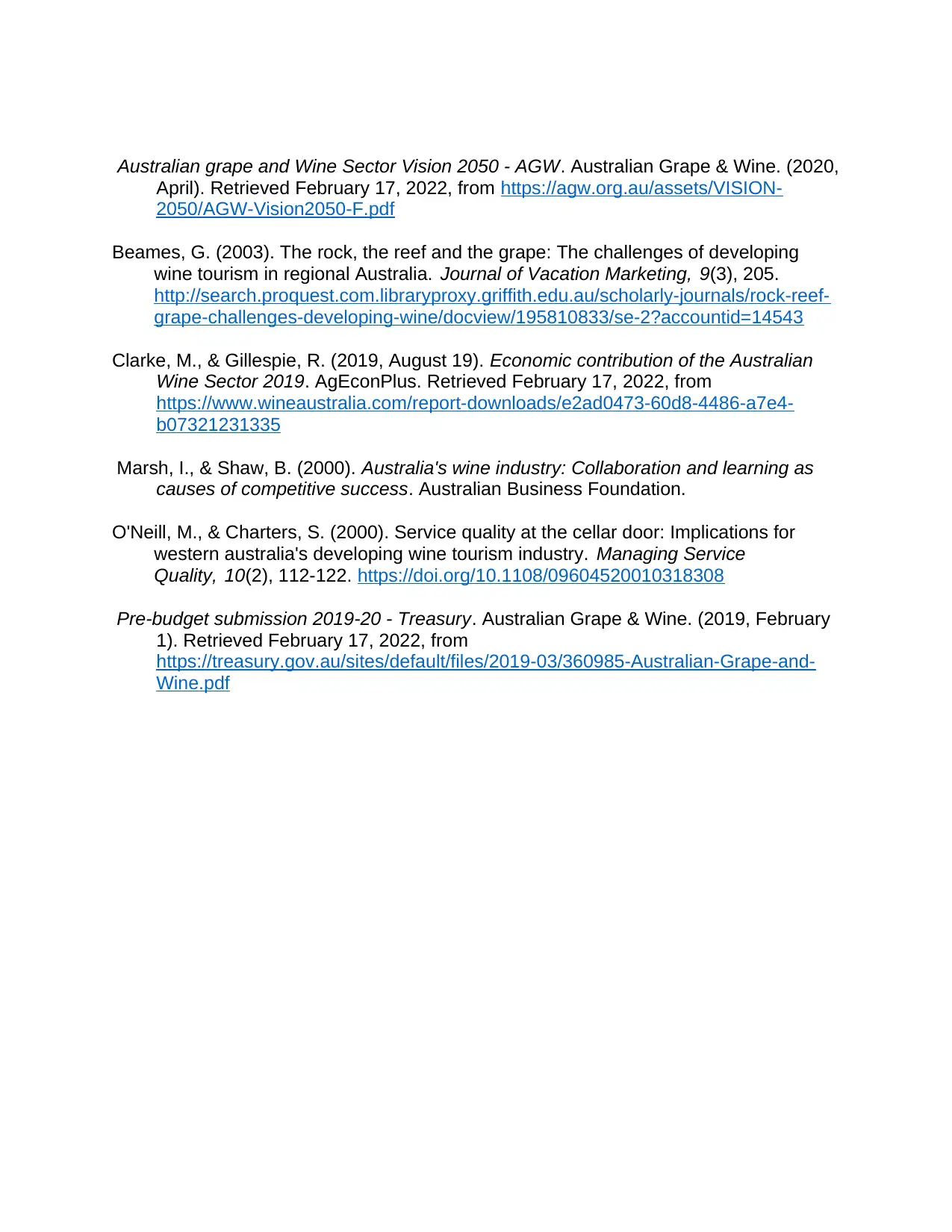Detailed Report: Australian Wine Industry Analysis and Development
VerifiedAdded on 2022/09/15
|5
|1292
|80
Report
AI Summary
This report provides a comprehensive overview of the Australian wine industry, highlighting its significant contribution to the Australian economy, particularly through exports and tourism. The analysis covers various aspects, including wine production across different regions, the role of organizations like the Australian Wine Research Institute (AWRI), and the development of a strong wine hierarchy. It also addresses current challenges such as the need for interdisciplinary cooperation between the wine and tourism sectors, customer perception of service quality, and the impact of market fluctuations. The report emphasizes the importance of strategic investments, including government support packages, to enhance market sentiment, increase sales, and boost wine-related tourism. Additionally, it discusses the significance of the cellar door experience, including staff professionalism and training, and the need for collaboration with food and beverage services and hotels. The report concludes by underscoring the importance of addressing these challenges and leveraging opportunities to sustain and grow the industry's contributions to the Australian economy.

1005GBS
Australia is a country known for its wine, and its wine industry is one of the
largest wine exporters in the world. Australia is considered the leading wine producing
country in the New World in both quality and industry size, with investment in research
and development extremely professional. The Australian Wine Research Institute
(AWRI) has contributed many technological advances to the wine industry, creating a
Revolution in the vineyards. A comprehensive wine hierarchy, with its own standards
and brand reputation, has also been developed and perfected in Australia. With the
terrain stretching through many climate zones, the vineyards here grow with extremely
rich natural conditions, making the grape varieties extremely diverse. Wine is produced
in all six Australian states, but most of the production is concentrated in the Southeast,
in New South Wales, Victoria and especially South Australia.
Some of Australia's famous vineyards include Barossa Valley and Hunter Valley.
Australian wines are as full of nuances as any wine system in the world, from pure
Shiraz, Southern Rhone-style blends, Riesling's classic fruit liqueurs from Eden to the
Clare Valley, or even the finest oak-aged Chardonnay, the Hunter Valley Semillon, the
fortified wine, and the dessert wine; Even expensive, sophisticated sparkling wine,
Australia can also produce with quality not inferior to any other country. Australian wine
brands have also established a strong position in the international market, as well as
many of the country's wine specialists who have established a certain reputation in the
world. In addition, this industry includes many areas such as wine grape growing,
winemaking, wine exporting and wine-related tourism. In Australia it plays an important
role in the economy, Australia input and output analysis has shown that the wine
industry contributes $45.5 billion in total output to the Australian economy, in addition, it
also supports more than 164,000 jobs in the Australian region (Clarke, Gillespie, 2019).
Although this industry is the contribution and synthesis of many different areas of
expertise and they make a huge contribution to the Australian economy, this industry
still has its problems that need to consider.
The wine industry is changing and evolving, with a $50 million government
support package that could support exports and wines in the region. Assisting in
enhancing market sentiment and sales in export markets, particularly the United States
and China, as well as increasing wine-related tourism in Australia are among the tasks
included in the package.. Also with that support package, Australian Grape & Wine has
Australia is a country known for its wine, and its wine industry is one of the
largest wine exporters in the world. Australia is considered the leading wine producing
country in the New World in both quality and industry size, with investment in research
and development extremely professional. The Australian Wine Research Institute
(AWRI) has contributed many technological advances to the wine industry, creating a
Revolution in the vineyards. A comprehensive wine hierarchy, with its own standards
and brand reputation, has also been developed and perfected in Australia. With the
terrain stretching through many climate zones, the vineyards here grow with extremely
rich natural conditions, making the grape varieties extremely diverse. Wine is produced
in all six Australian states, but most of the production is concentrated in the Southeast,
in New South Wales, Victoria and especially South Australia.
Some of Australia's famous vineyards include Barossa Valley and Hunter Valley.
Australian wines are as full of nuances as any wine system in the world, from pure
Shiraz, Southern Rhone-style blends, Riesling's classic fruit liqueurs from Eden to the
Clare Valley, or even the finest oak-aged Chardonnay, the Hunter Valley Semillon, the
fortified wine, and the dessert wine; Even expensive, sophisticated sparkling wine,
Australia can also produce with quality not inferior to any other country. Australian wine
brands have also established a strong position in the international market, as well as
many of the country's wine specialists who have established a certain reputation in the
world. In addition, this industry includes many areas such as wine grape growing,
winemaking, wine exporting and wine-related tourism. In Australia it plays an important
role in the economy, Australia input and output analysis has shown that the wine
industry contributes $45.5 billion in total output to the Australian economy, in addition, it
also supports more than 164,000 jobs in the Australian region (Clarke, Gillespie, 2019).
Although this industry is the contribution and synthesis of many different areas of
expertise and they make a huge contribution to the Australian economy, this industry
still has its problems that need to consider.
The wine industry is changing and evolving, with a $50 million government
support package that could support exports and wines in the region. Assisting in
enhancing market sentiment and sales in export markets, particularly the United States
and China, as well as increasing wine-related tourism in Australia are among the tasks
included in the package.. Also with that support package, Australian Grape & Wine has
Paraphrase This Document
Need a fresh take? Get an instant paraphrase of this document with our AI Paraphraser

great potential to regain market share in the US. Since the GFC had a big influence on
their market launch, Australian wines have underperformed and Australia has lost a
significant place in the premium classification to competitors that depend on a number
of factors such as currency rates, customer awareness and falling demand. Investing in
the US will help them reach their full potential in this market, resulting in a $1 billion
increase in annual revenue. They hope that the extra investment, if any, will help the
economy thrive (Australian Grape & Wine, 2019).
Besides, the lack of interdisciplinary cooperation between the wine and tourism sectors
is a worrying problem in the alcohol business. In addition to building sales, provide
tourists with memorable experiences such as dining, local products, recreational and
sporting activities, meeting locals, and sightseeing. beautiful (Beames, 2003). Although
there is a lot of potential and growth, the wine tourism industry is also a relatively new
tourism business, so it is likely to grapple with a range of development challenges that
affect its survival. and its long-term profitability. One of these concerns is customer
perception of service quality at the entrance to the tunnel and how it affects user
satisfaction, future purchase intention, and brand loyalty (O'Neill, Charters, 2000).
To address the issues stated above, such as support fees and the quality of
tourism services, the wine business must spend wisely and with particular aims in mind,
such as a desire to uncover new prospects. build storage facilities in important areas
and fortify direct relationships with distributors and retailers. This will allow for a more
strategic focus on activities that go beyond promotional events, allowing for the
development of long-term, successful supply chains built on solid partnerships
(Australian Grape & Wine, 2019).
In addition, when visiting and enjoying the vineyard and wine, the cellar door will often
be the first concern. Therefore, every element of the hatch (including layout, interface,
and personnel) is very important. In addition, the staff who open the basement doors
play an important part in the winery's tourist experience. The professionalism of the
vineyard staff, friendliness, kindness, general service, and expertise are also essential
factors in deciding whether tourists buy wine from them. The success of the tasting
room will depend on hiring and training the right people. Therefore, while designing
cellar doors at a winery, the selection and training of personnel should be a top priority
(O'Neill, Charters, 2000). In addition, in order to attract more tourists, the wine industry
in addition to linking with the tourism industry also needs to link with food and beverage
services and hotels, which can help distribute and introduce wine to more tourists
(Australian Grape & Wine, 2020).
their market launch, Australian wines have underperformed and Australia has lost a
significant place in the premium classification to competitors that depend on a number
of factors such as currency rates, customer awareness and falling demand. Investing in
the US will help them reach their full potential in this market, resulting in a $1 billion
increase in annual revenue. They hope that the extra investment, if any, will help the
economy thrive (Australian Grape & Wine, 2019).
Besides, the lack of interdisciplinary cooperation between the wine and tourism sectors
is a worrying problem in the alcohol business. In addition to building sales, provide
tourists with memorable experiences such as dining, local products, recreational and
sporting activities, meeting locals, and sightseeing. beautiful (Beames, 2003). Although
there is a lot of potential and growth, the wine tourism industry is also a relatively new
tourism business, so it is likely to grapple with a range of development challenges that
affect its survival. and its long-term profitability. One of these concerns is customer
perception of service quality at the entrance to the tunnel and how it affects user
satisfaction, future purchase intention, and brand loyalty (O'Neill, Charters, 2000).
To address the issues stated above, such as support fees and the quality of
tourism services, the wine business must spend wisely and with particular aims in mind,
such as a desire to uncover new prospects. build storage facilities in important areas
and fortify direct relationships with distributors and retailers. This will allow for a more
strategic focus on activities that go beyond promotional events, allowing for the
development of long-term, successful supply chains built on solid partnerships
(Australian Grape & Wine, 2019).
In addition, when visiting and enjoying the vineyard and wine, the cellar door will often
be the first concern. Therefore, every element of the hatch (including layout, interface,
and personnel) is very important. In addition, the staff who open the basement doors
play an important part in the winery's tourist experience. The professionalism of the
vineyard staff, friendliness, kindness, general service, and expertise are also essential
factors in deciding whether tourists buy wine from them. The success of the tasting
room will depend on hiring and training the right people. Therefore, while designing
cellar doors at a winery, the selection and training of personnel should be a top priority
(O'Neill, Charters, 2000). In addition, in order to attract more tourists, the wine industry
in addition to linking with the tourism industry also needs to link with food and beverage
services and hotels, which can help distribute and introduce wine to more tourists
(Australian Grape & Wine, 2020).

To conclude, the wine industry is one of the industries that bring many benefits to
the Australian economy not only in terms of exports but also in terms of tourism. Of
course, every industry will have problems, and of course there will also be solutions to
solve and support them. on the other hand, this is also the industry that provides job
opportunities for people and is also the industry that gives Australia its popularity when
mention wine.
References
the Australian economy not only in terms of exports but also in terms of tourism. Of
course, every industry will have problems, and of course there will also be solutions to
solve and support them. on the other hand, this is also the industry that provides job
opportunities for people and is also the industry that gives Australia its popularity when
mention wine.
References
⊘ This is a preview!⊘
Do you want full access?
Subscribe today to unlock all pages.

Trusted by 1+ million students worldwide

Australian grape and Wine Sector Vision 2050 - AGW. Australian Grape & Wine. (2020,
April). Retrieved February 17, 2022, from https://agw.org.au/assets/VISION-
2050/AGW-Vision2050-F.pdf
Beames, G. (2003). The rock, the reef and the grape: The challenges of developing
wine tourism in regional Australia. Journal of Vacation Marketing, 9(3), 205.
http://search.proquest.com.libraryproxy.griffith.edu.au/scholarly-journals/rock-reef-
grape-challenges-developing-wine/docview/195810833/se-2?accountid=14543
Clarke, M., & Gillespie, R. (2019, August 19). Economic contribution of the Australian
Wine Sector 2019. AgEconPlus. Retrieved February 17, 2022, from
https://www.wineaustralia.com/report-downloads/e2ad0473-60d8-4486-a7e4-
b07321231335
Marsh, I., & Shaw, B. (2000). Australia's wine industry: Collaboration and learning as
causes of competitive success. Australian Business Foundation.
O'Neill, M., & Charters, S. (2000). Service quality at the cellar door: Implications for
western australia's developing wine tourism industry. Managing Service
Quality, 10(2), 112-122. https://doi.org/10.1108/09604520010318308
Pre-budget submission 2019-20 - Treasury. Australian Grape & Wine. (2019, February
1). Retrieved February 17, 2022, from
https://treasury.gov.au/sites/default/files/2019-03/360985-Australian-Grape-and-
Wine.pdf
April). Retrieved February 17, 2022, from https://agw.org.au/assets/VISION-
2050/AGW-Vision2050-F.pdf
Beames, G. (2003). The rock, the reef and the grape: The challenges of developing
wine tourism in regional Australia. Journal of Vacation Marketing, 9(3), 205.
http://search.proquest.com.libraryproxy.griffith.edu.au/scholarly-journals/rock-reef-
grape-challenges-developing-wine/docview/195810833/se-2?accountid=14543
Clarke, M., & Gillespie, R. (2019, August 19). Economic contribution of the Australian
Wine Sector 2019. AgEconPlus. Retrieved February 17, 2022, from
https://www.wineaustralia.com/report-downloads/e2ad0473-60d8-4486-a7e4-
b07321231335
Marsh, I., & Shaw, B. (2000). Australia's wine industry: Collaboration and learning as
causes of competitive success. Australian Business Foundation.
O'Neill, M., & Charters, S. (2000). Service quality at the cellar door: Implications for
western australia's developing wine tourism industry. Managing Service
Quality, 10(2), 112-122. https://doi.org/10.1108/09604520010318308
Pre-budget submission 2019-20 - Treasury. Australian Grape & Wine. (2019, February
1). Retrieved February 17, 2022, from
https://treasury.gov.au/sites/default/files/2019-03/360985-Australian-Grape-and-
Wine.pdf
Paraphrase This Document
Need a fresh take? Get an instant paraphrase of this document with our AI Paraphraser

1 out of 5
Related Documents
Your All-in-One AI-Powered Toolkit for Academic Success.
+13062052269
info@desklib.com
Available 24*7 on WhatsApp / Email
![[object Object]](/_next/static/media/star-bottom.7253800d.svg)
Unlock your academic potential
Copyright © 2020–2025 A2Z Services. All Rights Reserved. Developed and managed by ZUCOL.





